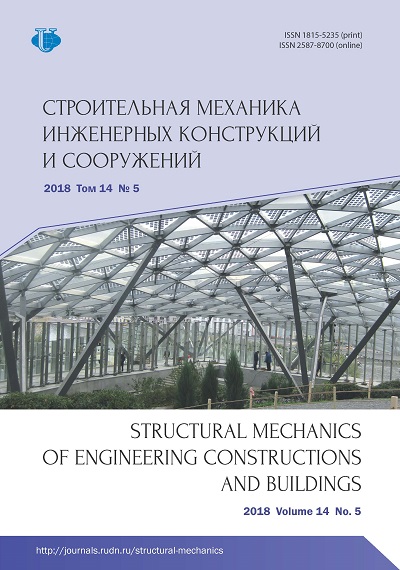Sustainability of walls of individual residential houses with a wooden frame
- Authors: Razzakov S.J1, Juraev B.G1, Juraev E.S1
-
Affiliations:
- Namangan Engineering Construction Institute
- Issue: Vol 14, No 5 (2018)
- Pages: 427-435
- Section: Buckling analysis
- URL: https://journals.rudn.ru/structural-mechanics/article/view/20208
- DOI: https://doi.org/10.22363/1815-5235-2018-14-5-427-435
Cite item
Full Text
Abstract
The aim of work. The stability of the walls of individual houses with a wooden frame and the stress-strain state of a single-story structure are investigated, and also problems of their strength and seismic resistance are considered. Solution technique. The development of a methodology for calculating small, simple in form individual houses, with the reinforcement of load-bearing walls by a frame, is described. The methodology includes the following stages: the creation of a mathematical model of structures; choice of the numerical method - the finite element method (FEM), which allows to take into account the structural features of the structure; carrying out calculations of buildings for specified loads. The choice of the finite element method is justified by the possibility of calculating a spatial model that takes into account the real geometry and structural features of the structure. Results. Using the spatial model allowed to take into account in detail the presence of the framework, and analysis of the stress-strain state revealed an increase in the rigidity of the structure with a skeleton, which indicates an increase in strength, stability, and seismic resistance. The connecting role of the skeleton is revealed, which consists in combining the elements of the structure into a single spatial system. The static effect consists in the perception of the rigid elements of the framework by the applied static load, which causes in them a slight deformation transferred to the piers between the frame elements. This leads to a uniform distribution and a general reduction in the level of stresses in the walls in comparison with the same stresses in walls without a frame.
About the authors
Sobirjon J Razzakov
Namangan Engineering Construction Institute
Author for correspondence.
Email: sobirjonrsj@gmail.com
Dr Sci. (Eng.), Professor of the Department of Construction of Buildings and Structures, Dean of the Construction-Technology Faculty
12 I.A. Karimov St., Namangan, 160103, Republic of UzbekistanBaxtiyor G Juraev
Namangan Engineering Construction Institute
Email: jurayevbahtiyor74@gmail.com
Competitor, Senior Lecturer of the Department of Construction of Buildings and Structures
12 I.A. Karimov St., Namangan, 160103, Republic of UzbekistanElyorbek S Juraev
Namangan Engineering Construction Institute
Email: maclaren1988@mail.ru
Competitor, Senior Lecturer of the Department of Construction of Buildings and Structures
12 I.A. Karimov St., Namangan, 160103, Republic of UzbekistanReferences
- Feodosev V.I. (1972). Soprotivlenie materialov [Resistance of material]. Moscow: Nauka Publ., 544. (In Russ.)
- Zenkevich O.K. (1975). Metod konechnix elementov v texnike [Finite element method on technic]. Moscow, Mir Publ., 542. (In Russ.)
- Zienkiewicz O.C., Parech C.J., Teply B. (1971). Three-dimensional analysis of buildings composed of floor and wall panels. Pros. Inst. of Civil Engineers, 49, 319–332.
- Razzakov S.J. (2016). Research of stress-strain state of single-storey buildings with internal partitions under static pulling load of the upper belt of a structure. Structural Mechanics of Engineering Constructions and Buildings, (6), 14–19. (In Russ.)
- Razzakov S.J., Kholmirzaev S.A. (2017). Influence of frame work strengthening on the stress-strain state of two-storey buildings of low-strength materials. Structural Mechanics of Engineering Constructions and Buildings, (4), 43–49. (In Russ.)
- Razzakov S.J. (2016). Experimental and theoretical approach to the determination of physical and mechanical characteristics of the material of the walls of the low-strength materials. European Science Review, (7–8), 215–216.
- Razzakov S.J. (2016). The study of seismic stability of a single-storey building with an internal partition with and without taking into account the frame. European Science Review, (7–8), 217–220.
- Razzakov S.J., Akhmedov P.S., Chulponov O.G., Mavlonov R.A. (2017). Stretching curved wooden frametype elements “Sinch”. European Science Review, (1–2), 223–225.
- Bolshakov V.I., Yatsenko Ye.A., Sossu G., Lemer M., Reynuar Zh.M., Kestens Zh., Kormo I. (2000). Yatsenko Ye.A. (Ed.). Osnovy metoda konechnykh elementov [Basis of finite element method]. Dnepropetrovsk, PGASA Publ., 255. (In Russ.)
- Makeyev V.B. (1975). Staticheskiy raschet zdaniy iz ob"yemnykh blokov metodom konechnykh elementov [Static calculation of buildings from volumetric blocks by the finite element method] (Cand. Sci. (Eng.) Dissertation). Moscow, MISI im. Kuybysheva Publ., 140. (In Russ.)
- Sinitsin A.P. (1967). Prakticheskiye metody rascheta sooruzheniy na seysmicheskiye nagruzki [Practical methods for calculating structures for seismic loads]. Moscow: Stroyizdat Publ., 145. (In Russ.)
- Handa K.H. (1972). Inplane vibration of box-type structures. Journal of Sound and Vibration, 21(2), 107–114.
- Postnov V.A. (1974). Metod konechnykh elementov v raschetakh sudovykh konstruktsiy [Finite element method in calculations of ship structures]. Leningrad: Sudostroyeniye Publ., 342. (In Russ.)
- Rutishaur H. (1970). Simultaneous iteration method for symmetric matrics. Num. Math., 16(3), 205–223.
















